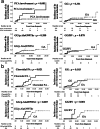RNF213 p.Arg4810Lys Wild Type is Associated with De Novo Hemorrhage in Asymptomatic Hemispheres with Moyamoya Disease
- PMID: 37269436
- PMCID: PMC11226534
- DOI: 10.1007/s12975-023-01159-z
RNF213 p.Arg4810Lys Wild Type is Associated with De Novo Hemorrhage in Asymptomatic Hemispheres with Moyamoya Disease
Abstract
Clinical implications of RNF213 genetic variants, other than p.Arg4810Lys, in moyamoya disease (MMD), remain unclear. This study aimed to investigate the association of RNF213 variants with clinical phenotypes in MMD. This retrospective cohort study collected data regarding the clinical characteristics of 139 patients with MMD and evaluated the angioarchitectures of 253 hemispheres using digital subtraction angiography at diagnosis. All RNF213 exons were sequenced, and the associations of clinical characteristics and angiographical findings with p.Arg4810Lys, p.Ala4399Thr, and other rare variants (RVs) were examined. Among 139 patients, 100 (71.9%) had p.Arg4810Lys heterozygote (GA) and 39 (28.1%) had the wild type (GG). Fourteen RVs were identified and detetcted in 15/139 (10.8%) patients, and p.Ala4399Thr was detected in 17/139 (12.2%) patients. Hemispheres with GG and p.Ala4399Thr presented with significantly less ischemic events and more hemorrhagic events at diagnosis (p = 0.001 and p = 0.028, respectively). In asymptomatic hemispheres, those with GG were more susceptible to de novo hemorrhage than those with GA (adjusted hazard ratio [aHR] 5.36) with an increased risk when accompanied by p.Ala4399Thr or RVs (aHR 15.22 and 16.60, respectively). Within the choroidal anastomosis-positive hemispheres, GG exhibited a higher incidence of de novo hemorrhage than GA (p = 0.004). The GG of p. Arg4810Lys was a risk factor for de novo hemorrhage in asymptomatic MMD hemispheres. This risk increased with certain other variants and is observed in choroidal anastomosis-positive hemispheres. A comprehensive evaluation of RNF213 variants and angioarchitectures is essential for predicting the phenotype of asymptomatic hemispheres in MMD.
Keywords: RNF213; Genotype; Moyamoya disease; Phenotype.
© 2023. The Author(s).
Conflict of interest statement
The authors declare no competing interests.
Figures


Similar articles
-
Association of Genetic Variants with Postoperative Donor Artery Development in Moyamoya Disease: RNF213 and Other Moyamoya Angiopathy-Related Gene Analysis.Transl Stroke Res. 2025 Jun;16(3):679-689. doi: 10.1007/s12975-024-01248-7. Epub 2024 Apr 9. Transl Stroke Res. 2025. PMID: 38592555 Free PMC article.
-
Stroke Events and Risk Factors in Older Patients with Moyamoya Disease.World Neurosurg. 2024 Jul;187:e405-e413. doi: 10.1016/j.wneu.2024.04.098. Epub 2024 Apr 22. World Neurosurg. 2024. PMID: 38657789
-
Association of rare variants in RNF213 with severe progression of intracranial artery stenosis in quasi-moyamoya disease.J Neurosurg. 2024 Sep 13;142(2):394-403. doi: 10.3171/2024.6.JNS24202. Print 2025 Feb 1. J Neurosurg. 2024. PMID: 39270321
-
Meta-analysis of the association between RNF213 polymorphisms and clinical features of moyamoya disease in Asian population.Clin Neurol Neurosurg. 2023 Aug;231:107801. doi: 10.1016/j.clineuro.2023.107801. Epub 2023 May 30. Clin Neurol Neurosurg. 2023. PMID: 37267801
-
Role of Ring Finger Protein 213 in Moyamoya Disease.Chin Med J (Engl). 2016 Oct 20;129(20):2497-2501. doi: 10.4103/0366-6999.191824. Chin Med J (Engl). 2016. PMID: 27748344 Free PMC article. Review.
Cited by
-
Association of Genetic Variants with Postoperative Donor Artery Development in Moyamoya Disease: RNF213 and Other Moyamoya Angiopathy-Related Gene Analysis.Transl Stroke Res. 2025 Jun;16(3):679-689. doi: 10.1007/s12975-024-01248-7. Epub 2024 Apr 9. Transl Stroke Res. 2025. PMID: 38592555 Free PMC article.
-
Moyamoya disease manifesting with bilateral involvement of the proximal vertebral arteries: A case report.Brain Circ. 2024 Dec 28;10(4):372-377. doi: 10.4103/bc.bc_37_24. eCollection 2024 Oct-Dec. Brain Circ. 2024. PMID: 40012600 Free PMC article.
-
Integrated bulk RNA sequencing and mass cytometry analysis reveal the circulating immune landscape in ischemic and hemorrhagic Moyamoya disease.BMC Immunol. 2025 Mar 10;26(1):19. doi: 10.1186/s12865-025-00699-3. BMC Immunol. 2025. PMID: 40065209 Free PMC article.
References
-
- Kamada F, Aoki Y, Narisawa A, Abe Y, Komatsuzaki S, Kikuchi A, Kanno J, Niihori T, Ono M, Ishii N, Owada Y, Fujimura M, Mashimo Y, Suzuki Y, Hata A, Tsuchiya S, Tominaga T, Matsubara Y, Kure S. A genome-wide association study identifies RNF213 as the first moyamoya disease gene. J Hum Genet. 2011;56:34–40. doi: 10.1038/jhg.2010.132. - DOI - PubMed
MeSH terms
Substances
LinkOut - more resources
Full Text Sources
